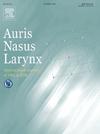Robotic and computer-assisted techniques in ear surgery
IF 1.5
4区 医学
Q2 OTORHINOLARYNGOLOGY
引用次数: 0
Abstract
Robotic and computer-assisted systems for ear surgery are receiving growing attention as tools to overcome the challenges intrinsic to the delicate, restricted operative field of the middle and inner ear. This review highlights recent advances in robotic platforms, clinical outcomes, and emerging technologies such as augmented reality (AR), virtual reality (VR), and artificial intelligence (AI). Multiple groups worldwide have introduced robotic devices that aid or automate tasks like mastoid drilling, stapes footplate fenestration, and cochlear implant (CI) electrode insertion. Seminal studies involving systems such as HEARO, iotaSoft, and RobOtol reveal sub-millimeter accuracy and minimized trauma during CI, suggesting the potential to reduce postoperative complications and improve hearing preservation.
Although these technologies have progressed from proof-of-concept prototypes to early clinical usage, significant barriers remain before they become routine. Cost is a key concern, given the relatively small patient population for otologic procedures compared to other surgical fields. Regulatory pathways also require strict safety validations, particularly for semi-autonomous or fully autonomous functions. Nevertheless, FDA and European CE approvals for certain robotic systems illustrate their growing feasibility. Meanwhile, AR- and VR-based navigation is improving intraoperative visualization by overlaying critical structures such as the facial nerve onto the surgeon’s field, while AI-driven algorithms for instrument tracking and real-time monitoring offer further enhancements in safety and precision. In addition, simulation-based training in VR environments can accelerate surgical expertise and reduce learning curves.
Larger-scale clinical trials that directly compare robotic and conventional approaches are still needed to quantify benefits related to complication rates, operative times, and long-term auditory outcomes. Ongoing innovations in software integration and miniaturized hardware are likely to broaden the range of feasible robotic tasks within the ear’s narrow anatomical boundaries.
耳部手术中的机器人和计算机辅助技术。
机器人和计算机辅助耳部手术系统作为克服中耳和内耳这一脆弱、受限手术领域固有挑战的工具,正受到越来越多的关注。本综述重点介绍了机器人平台、临床结果和新兴技术(如增强现实(AR)、虚拟现实(VR)和人工智能(AI))的最新进展。世界各地的多个组织已经推出了机器人设备,以帮助或自动化诸如乳突钻孔,镫骨踏板开窗和耳蜗植入(CI)电极插入等任务。包括HEARO、iotaSoft和RobOtol等系统在内的开创性研究表明,在CI过程中,亚毫米级的精度和最小的创伤表明了减少术后并发症和改善听力保护的潜力。尽管这些技术已经从概念验证原型发展到早期临床应用,但在成为常规应用之前仍存在重大障碍。考虑到与其他外科领域相比,耳科手术的患者人数相对较少,成本是一个关键问题。监管途径也需要严格的安全验证,特别是对于半自主或完全自主的功能。尽管如此,FDA和欧洲CE对某些机器人系统的批准表明它们越来越可行。与此同时,基于AR和vr的导航通过将面部神经等关键结构覆盖到外科医生的视野上,正在改善术中可视化,而用于仪器跟踪和实时监控的人工智能驱动算法进一步提高了安全性和精度。此外,在VR环境中基于模拟的培训可以加速外科专业知识并减少学习曲线。更大规模的临床试验,直接比较机器人和传统的方法,仍然需要量化相关的并发症发生率,手术时间和长期听觉结果的好处。软件集成和小型化硬件的持续创新可能会在耳朵狭窄的解剖边界内扩大可行机器人任务的范围。
本文章由计算机程序翻译,如有差异,请以英文原文为准。
求助全文
约1分钟内获得全文
求助全文
来源期刊

Auris Nasus Larynx
医学-耳鼻喉科学
CiteScore
3.40
自引率
5.90%
发文量
169
审稿时长
30 days
期刊介绍:
The international journal Auris Nasus Larynx provides the opportunity for rapid, carefully reviewed publications concerning the fundamental and clinical aspects of otorhinolaryngology and related fields. This includes otology, neurotology, bronchoesophagology, laryngology, rhinology, allergology, head and neck medicine and oncologic surgery, maxillofacial and plastic surgery, audiology, speech science.
Original papers, short communications and original case reports can be submitted. Reviews on recent developments are invited regularly and Letters to the Editor commenting on papers or any aspect of Auris Nasus Larynx are welcomed.
Founded in 1973 and previously published by the Society for Promotion of International Otorhinolaryngology, the journal is now the official English-language journal of the Oto-Rhino-Laryngological Society of Japan, Inc. The aim of its new international Editorial Board is to make Auris Nasus Larynx an international forum for high quality research and clinical sciences.
 求助内容:
求助内容: 应助结果提醒方式:
应助结果提醒方式:


